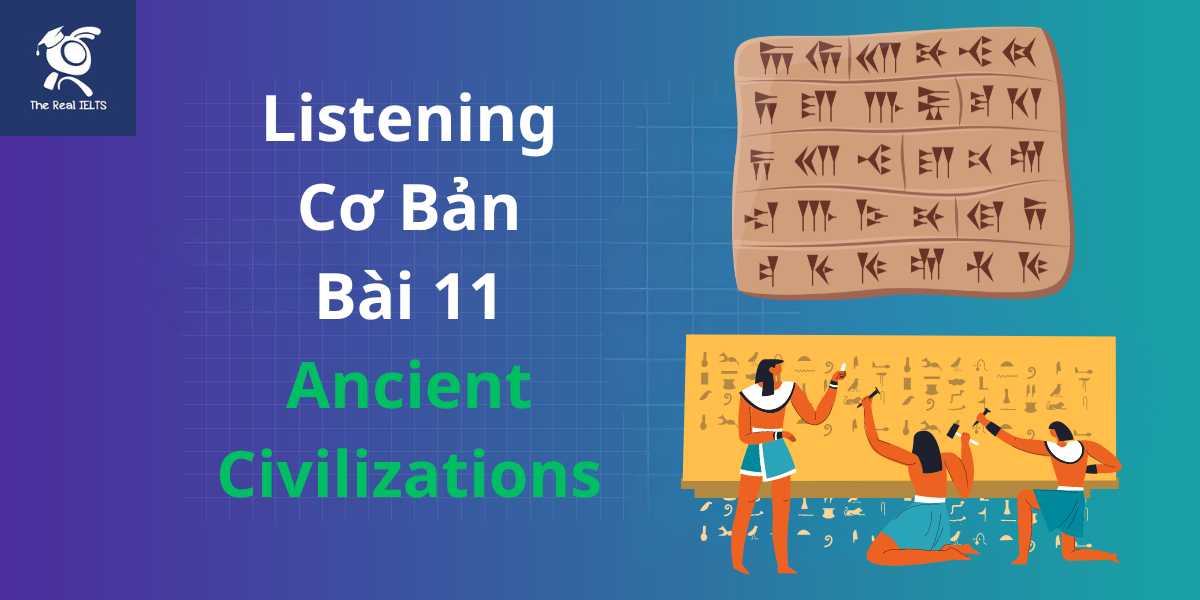Bài Listening lần này nói về các nền văn hóa cổ đại và di sản được để lại. Ngay sau đây là bài Listening, bài nghe này sẽ có nhiều từ vựng tiếng Anh chuyên ngành nên trong phần script sẽ có liệt kê các từ vựng cần nắm được trong chủ đề này.
Bài nghe
Câu hỏi
- Multiple Choice: Which ancient civilization is known for developing one of the earliest writing systems called hieroglyphics?
- A. Ancient Greece
- B. Ancient Rome
- C. Ancient Egypt
- D. Mesopotamia
- True or False: The Sumerians were responsible for the creation of the Parthenon.
- Short Answer: What are two key contributions of the Ancient Roman civilization mentioned in the passage?
- Multiple Choice: Which civilization is credited with advanced urban planning and impressive engineering skills, particularly in cities like Harappa and Mohenjo-Daro?
- A. Ancient Egypt
- B. Indus Valley Civilization
- C. Mesopotamia
- D. Ancient Greece
- Short Answer: Name two inventions attributed to ancient China.
- True or False: Ancient Greek philosophers like Socrates, Plato, and Aristotle have no influence on contemporary thought.
Gợi ý trả lời
- C. Ancient Egypt
- False (The Parthenon was created by the ancient Greeks)
- Roman law and extensive road networks
- B. Indus Valley Civilization
- Paper and gunpowder
- False (Ancient Greek philosophers have a significant influence on contemporary thought)
Script bài nghe
Throughout history, numerous ancient civilizations have left indelible marks on our modern world. These legacies manifest in various forms, from architectural marvels and technological innovations to profound philosophical ideas and complex societal structures.
One of the most influential ancient civilizations is Ancient Egypt. Renowned for its monumental pyramids and the enigmatic Sphinx, Egypt’s contributions extend far beyond architecture. The Egyptians developed one of the earliest writing systems, known as hieroglyphics, which played a crucial role in administrative and religious documentation. Furthermore, their advancements in medicine and astronomy laid foundational principles still referenced today.
In Mesopotamia, often termed the cradle of civilization, the Sumerians invented cuneiform script, which is one of the oldest known writing systems. This civilization also produced the Code of Hammurabi, one of the earliest and most complete written legal codes, influencing legal thought for millennia. Their development of irrigation and agricultural techniques supported sustained urban growth and social complexity.
Moving to the Indus Valley Civilization, this society is credited with advanced urban planning and impressive engineering skills. Cities like Harappa and Mohenjo-Daro were characterized by their well-organized grid layouts, sophisticated drainage systems, and impressive bathhouses. Despite the civilization’s mysterious decline, its contributions to urban planning remain significant.
Ancient Greece, often hailed as the birthplace of Western civilization, introduced ideas that still underpin modern philosophy, politics, and science. The works of philosophers like Socrates, Plato, and Aristotle continue to influence contemporary thought. Moreover, Greek innovations in art, theater, and architecture, exemplified by structures like the Parthenon, have left a lasting legacy.
Similarly, Ancient Rome’s impact is evident in today’s legal systems, engineering, and governance. The Roman Empire’s extensive road networks facilitated trade and communication across Europe, many of which evolved into modern roadways. Roman law forms the basis for many legal systems around the world, and their architectural innovations, such as the use of concrete and the arch, revolutionized building construction.
Lastly, the contributions of ancient China are vast and varied, including the invention of paper, gunpowder, and the compass. The Great Wall, an extraordinary feat of engineering, symbolizes both the ingenuity and the defensive prowess of ancient China. Philosophical teachings from Confucius and Laozi continue to influence Eastern and Western societies alike.
In conclusion, ancient civilizations have bequeathed a rich tapestry of legacies that continue to shape our modern world. By studying these civilizations, we gain insights not only into their innovative minds but also into the enduring nature of human creativity and resilience.
Từ vựng cần nắm được trong bài nghe này
- Ancient civilizations – Các nền văn minh cổ đại
- Legacies – Di sản
- Architectural marvels – Kỳ quan kiến trúc
- Technological innovations – Các cải tiến công nghệ
- Philosophical ideas – Các ý tưởng triết học
- Societal structures – Các cấu trúc xã hội
- Monumental pyramids – Các kim tự tháp vĩ đại
- Enigmatic Sphinx – Tượng Nhân sư bí ẩn
- Hieroglyphics – Chữ tượng hình
- Administrative and religious documentation – Tài liệu hành chính và tôn giáo
- Advancements in medicine and astronomy – Các tiến bộ trong y học và thiên văn học
- Cuneiform script – Chữ hình nêm
- Code of Hammurabi – Bộ luật Hammurabi
- Legal codes – Các bộ luật
- Irrigation and agricultural techniques – Các kỹ thuật tưới tiêu và nông nghiệp
- Urban planning – Quy hoạch đô thị
- Drainage systems – Hệ thống thoát nước
- Bathhouses – Nhà tắm công cộng
- Philosophy, politics, and science – Triết học, chính trị và khoa học
- Parthenon – Đền Parthenon
- Legal systems – Hệ thống pháp luật
- Road networks – Mạng lưới đường xá
- Architectural innovations – Các đổi mới về kiến trúc
- Concrete and the arch – Bê tông và vòm
- Paper, gunpowder, and the compass – Giấy, thuốc súng và la bàn
- Great Wall – Vạn Lý Trường Thành
- Engineering – Kỹ thuật
- Defensive prowess – Khả năng phòng thủ
- Philosophical teachings – Các giáo lý triết học
- Human creativity and resilience – Sự sáng tạo và khả năng phục hồi của con người
Nghe lại bài Listening cũ: Bài tập Listening 10: Sustainable Agriculture Practices.















